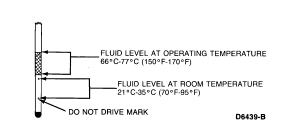 CAUTION: Vehicle should not be driven if fluid level is below the bottom hole.
CAUTION: Vehicle should not be driven if fluid level is below the bottom hole. Section 07-01B: Transmission, Automatic—AOD | 1993 Mustang Workshop Manual |
Troubleshooting the automatic transmission is simplified by using the proven method of diagnosis. One of the most important things to remember is that there is a definite procedure to follow. Do not take short cuts or assume that critical checks or adjustments have already been made.
The following procedures are recommended for checking and/or verifying that the various components are adjusted and operating properly. Use Rotunda Automatic Transmission Tester 014-00737 or equivalent. Follow the manufacturer's instructions.
 CAUTION: Vehicle should not be driven if fluid level is below the bottom hole.
CAUTION: Vehicle should not be driven if fluid level is below the bottom hole.
Transmission Hot—Operating Temperature
The automatic transmission should be checked at an operating temperature of 66°C-77°C (150° F-170°F) (dipstick is hot to touch). The operating temperature may be obtained by driving 24-32 km (15-20 miles) of city-type driving with the outside temperature above 10°C (50°F).
Dipstick Reading: Fluid level at operating temperature.
Fluid level on dipstick should be within the cross-hatched area.
Transmission Cold—Room Temperature
If the transmission is not at an operating temperature of 66°C - 77°C (150°F - 170°F) and it becomes necessary to check the fluid level (such as pre-delivery) the fluid may be checked at room temperature of 21°C - 35°C (70°F - 95°F) (dipstick cool to touch).
Dipstick Reading: Fluid level at room temperature.
Fluid level on the dipstick should read between the holes at room
temperature. 
Check fluid level at operating temperature or room temperature as follows:
NOTE: The fluid level indication on the dipstick will be different at operating temperature and room temperature. For the correct fluid level reading on the dipstick, follow the appropriate instructions stated previously.
Before adding fluid, ensure that Synthetic MERCON® Multi-Purpose Automatic Transmission Fluid E6AZ-19582-B (ESR-M2C163-A2) or equivalent will be used. Only use fluid that meets or exceeds the specification stamped on the dipstick.
 CAUTION: If vehicle has been operated for an extended period at high speed, in
city traffic, in hot weather, or vehicle is being used to pull a trailer, the
fluid has to cool approximately 30 minutes after engine has been turned off to
obtain an accurate reading.
CAUTION: If vehicle has been operated for an extended period at high speed, in
city traffic, in hot weather, or vehicle is being used to pull a trailer, the
fluid has to cool approximately 30 minutes after engine has been turned off to
obtain an accurate reading.
 CAUTION: Use of a fluid other than specified could result in transmission
malfunction and/or failure.
CAUTION: Use of a fluid other than specified could result in transmission
malfunction and/or failure.
If necessary, add enough fluid through the filler tube to raise the level to the correct position.
 CAUTION: Do not overfill the transmission. This will result in foaming, loss of
fluid through the vent and possible transmission malfunction. If overfill
occurs, excess fluid must be removed.
CAUTION: Do not overfill the transmission. This will result in foaming, loss of
fluid through the vent and possible transmission malfunction. If overfill
occurs, excess fluid must be removed.
If the transmission fluid level is correctly established at 21°C-35°C (70° F-95°F), it will appear in the cross-hatch area on the dipstick when the transmission reaches an operating temperature of 66°C-77°C (150° F-170°F). Do not overfill or underfill.
Underfill can result in transmission loss of engagement or slipping. This condition is most evident in cold weather or when the vehicle is parked or being driven on a hill.
If the transmission fluid level is checked when the fluid is at room temperature, the dipstick could indicate that fluid should be added if the dipstick is misread. If fluid is added at this time, an overfill condition could result when the fluid reaches operating temperatures of 66°C-77°C (150° F-170°F) (dipstick hot to touch).